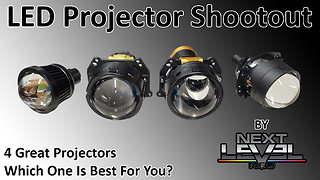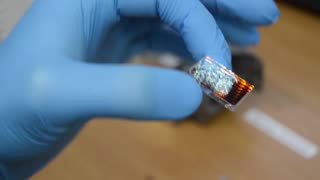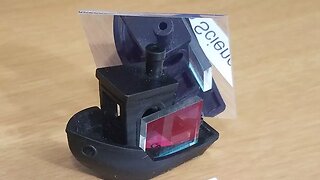#177 Digital Light Processing (DLP)
Digital Light Processing (DLP) is a technology used in many display and projection systems, particularly in projectors and some high-definition televisions. It was invented by Dr. Larry Hornbeck of Texas Instruments in 1987. DLP works on the principle of reflecting light off tiny mirrors to create an image. Here's how it works:
Digital Micromirror Device (DMD): At the heart of DLP technology is a chip called the Digital Micromirror Device (DMD). This chip contains thousands to millions of tiny mirrors, each only a few micrometers in size. These mirrors are arranged in a grid pattern.
Light Source: DLP projectors typically use a high-intensity lamp or LED as a light source. The light is typically white, but some DLP projectors use lasers to provide a more precise and colorful light source.
Color Wheel (optional): Some DLP systems use a color wheel to produce colors. This color wheel consists of different colored filters (usually red, green, and blue) that rotate in front of the light source. As the filters spin, the light is filtered to produce different colors.
Mirror Manipulation: Each tiny mirror on the DMD chip can be independently tilted in two positions: toward the light source (on) or away from it (off). When a mirror is tilted toward the light source, it reflects light onto the screen, creating a bright pixel. When tilted away, it does not reflect light and creates a dark pixel. By rapidly toggling the mirrors on and off, grayscale shades and colors are produced.
Image Processing: Before reaching the DMD chip, the input image is processed and converted into digital signals that control each mirror's position. This involves breaking the image into a series of pixels and determining how each mirror should behave to reproduce the image accurately.
Projection: The light, now manipulated by the DMD chip to form the desired image, is projected onto a screen or surface. The projection lens focuses the light to create a sharp and clear image.
DLP technology offers several advantages:
Sharpness: DLP projectors can produce sharp and detailed images because the mirrors can switch on and off very quickly.
Color Accuracy: DLP can produce vibrant and accurate colors, especially when used with a high-quality color wheel or laser light source.
Longevity: DLP projectors often have a long lifespan and require minimal maintenance since there are no bulbs to replace, as is common in traditional projectors.
Reduced Pixelation: The tiny mirrors reduce the pixelation effect commonly seen in some other projection technologies.
DLP is widely used in home theater projectors, business projectors, digital cinema projection systems, and even some high-end televisions. However, it's important to note that while DLP has many advantages, it also has some limitations, such as the potential for the "rainbow effect" in some viewers (seeing flashes of color), especially in single-chip DLP systems with color wheels. Advancements in DLP technology continue to address these limitations and improve image quality.
www.antharas.co.uk/ companies website or top book distributors!
#BusinessStrategy
#Entrepreneurship
#Leadership
#Management
#Marketing
#Finance
#Startups
#Innovation
#Sales
#SmallBusiness
#CorporateCulture
#Productivity
#SelfDevelopment
#SuccessStories
#PersonalBranding
#Networking
#Negotiation
#BusinessEthics
#TimeManagement
#GrowthStrategies
#MarketAnalysis
#BusinessPlanning
#FinancialManagement
#HumanResources
#CustomerExperience
#DigitalTransformation
#Ecommerce
#SocialMediaMarketing
#BusinessCommunication
#ChangeManagement
-
 44:17
44:17
NextLevelNeo
10 months agoUltimate NLN LED Projector Comparison: Find Your Perfect Pick!
3 -
 7:58
7:58
Peter von Panda
5 years agoSuper Bright 4500 Lumens HD LED Projector by PFERDEKI Review
231 -
 6:35
6:35
Ridout
11 months agoPhotography lights review. #photography
60 -
 7:57
7:57
Peter von Panda
5 years agoSuper Small 2300 Lumens LED Movie Projector Review
441 -
 24:17
24:17
GarageScience
1 year agoUPDATE: UV Pass Filter DLP Projector Mod ~ How well did it work in my SLA Printer?
21 -
 12:58
12:58
ALLCHECKOUT
2 months agoQIAOLET Mini Projector, Rechargeable Ultra Portable DLP Projector OF01, Full Review
71 -
 10:38
10:38
Peter von Panda
7 years ago1800 Lumens 180" Portable Mini Home LED Projector Review
271 -
 8:34
8:34
GarageScience
1 year agoDLP Projector UV Pass Filter Installation Guide
10 -
 13:26
13:26
Peter von Panda
6 years agoDR.J 1500 Lumens Portable Mini LED Projector (170 Inch Max Projection Display) Full Test and Review
471 -
 38:48
38:48
Darren Yeo
1 year agoLedlenser P6R Core QC Review - Unique RGBW Multicoloured Light with flood to zoom beam +18650 cell
50